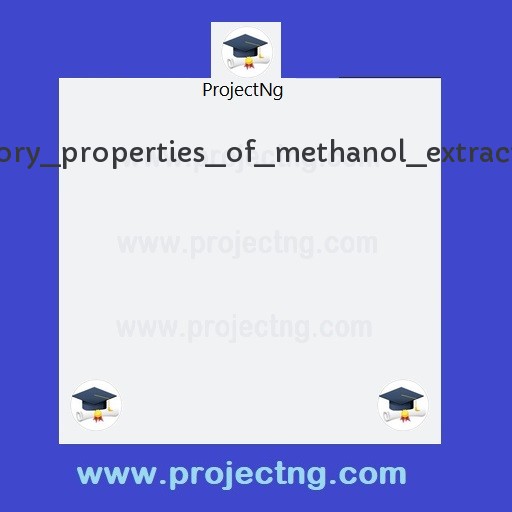Phytochemical and anti-inflammatory properties of methanol extract of crateva adansonii stem bark.
Bio-chemistry Project Topics
Get the Complete Project Materials Now! »
PHYTOCHEMICAL_AND_ANTI-INFLAMMATORY_PROPERTIES_OF_METHANOL_EXTRACT_OF_CRATEVA_ADANSONII_STEM_BARK.
CHAPTER ONE
1.0 INTRODUCTION
Inflation is a Latin word (inflammare) which is translated means to set on fire. It is a complex biological response of vascular tissue to harmful stimuli such as pathogens, damaged cells irritant. Inflammation is the reaction of vascularized tissue to local injury caused by certain stimuli like infections, chemicals and biochemical agents, thermal or other physical trauma, antigen-antibody interaction etc (Carol, 1994). Without inflammatory response, wounds will not heal and minor infections would be over weening. Though inflammation aims at limiting damage and restoring function, some enzymes and toxic products within phagocytic cells are released to the extend of damaging the tissue. The advent of anti-inflammatory agents has made inflammation which as been a threat to human life due to its complex, multicontent, to loose its power. These anti-inflammatory agents or drugs help reduce, pain by inhibiting inflammation as opposed to opioids, which affects the central nervous system. It also prevent repairs, prevent and stop the consequences of inflammation by acting on the body responses without directly antagonizing the causative agent (Stedman, 2000). These anti-inflammatory process involves the process of balancing pro-inflammatory acute-phase reactants (Russell et al. 2000), altering biochemical pathway
78
forming prostaglandins by inhibiting cyclooxygenase enzyme from catalyzing the reaction, as a result, suppress, compensate and correct the mechanical and structural abnormalities by assistive device. (Masumoto et al.2009).
The inflammatory reaction is phylogenetically and ontogenetically the oldest defense mechanism. The cells of immune system are widely distributed throughout the body, but if an infection or tissue damage occurs. It is necessary to concentrate them and their products at the site of damage.
Three major events occurring during this response:
1. An increased blood supply to the damaged tissue . It is performed by vasodilation. The inflamed tissue look like containing greater number of vessels.
2. Increased capillary permeability caused by retraction of the endothelial cells. This permits larger molecules than usual to escape from the capillaries, and thus allows the soluble mediators of immunity to reach the site of inflammation.
3. Leukocytes migrates out of the capillaries into the surrounding tissues. In the earliest stages of inflammation, neutrophils are particularly
78
prevalent, but later monocytes and lymphocytes migrate towards the site of infection (Ashcroft et al.1999).
For the possibility of surrounding tissue damage, inflammatory responses must be well ordered and controlled. The body must be able to act quickly in some situations, for example to reduce or stop the lost of blood, whereas tissue repair can begin later. Therefore a wide variety of interconnected cellular and humoral (soluble) mechanisms are activated when tissue damage and infections occur. On the other hand, if injury is negligible, the body must have mechanisms which are able to stop tissue damage when the agent is removed. The development of inflammatory reactions is controlled by cytokines, products of plasma enzymes (complement, the coagulation clotting, kinin and fibrolytic pathways), by lipid mediators (prostaglandin and leukotrienes) released from different cells/ and by vasoactive mediators from the mast cells, basophils and platelets. These anti-inflammatory reactions differ. Fast-acting mediators such as vasoactive amines and the product of the kininsystem, modulate the immediate response. Later, newly synthesized mediators such as leukotrienes are involved in the accumulation and activation of other cells. However, in inflammatory reactions initiated by the immune system, the ultimate control is exerted by the antigen itself in the same ways it controls the immune response itself. For this reason, the
78
cellular accumulation at the site of chronic infection or auto-immune reactions where antigen cannot ultimately be eradicated, is quiet different from the sites were antigenic stimulus can be rapidly cleared.
The nervous system can also participate in the control of inflammation especially axon reflexes, but inflammation may be realized in non-nervous tissues as well.
Inflammation may become chronic in certain settings where the acute process characterized by neutrophil infiltration and swelling gives way to predominance of mononuclear phagocytes and lymphocytes.This probably occurs to some degree with the normal healing process but becomes exaggerated and chronic when there’s ineffective elimination of foreign materials as in certain infections (e.g tuberculosis) or following introduction of foreign bodies (example asbestos) or deposition of crystals (example urate crystals). Chronic inflammation is often associated with fussion of mononuclear cells to form multinucleated gigantic cells, which eventually become granuloma. Chronic inflammation is seen under of delayed hypersensitivity (Nathan, 2002).
78
Be the First to Share On Social















